TEXT BY SHASHVAT SHUKLA
PHOTOGRAPHS BY NAVDHA MALHOTRA
New Delhi, India
This is a Kadhai: an object so ubiquitous and familiar in India, such an unremarkably standard feature of utensil racks, that it is often forgotten – as are its stories.
This Kadhai dates back to sometime around 1951, when it was gifted to my grandmother – a young girl of less than sixteen – at her wedding. She was marrying my grandfather – her cousins’ neighbour in Benares – a man nine years her senior with a sparkling new job at a sparkling new bank intended to uplift the masses of a sparkling new country. The wedding itself was a nondescript affair; the Marathi custom of a quick morning ceremony was hardly noticed by the late night revellers of Lucknow. There weren’t many gifts to begin with, but this kadhai – bought from Lucknow’s old Chowk market by my great-grandmother’s youngest sister – stood out from among the sarees and shirt fabric pieces. Unlike most utensils of the time, this kadhai was made of stainless steel instead of aluminium – a luxury reserved for indeed the most significant of occasions – and quickly became the mainstay of a hastily assembled, scrappy new kitchen.
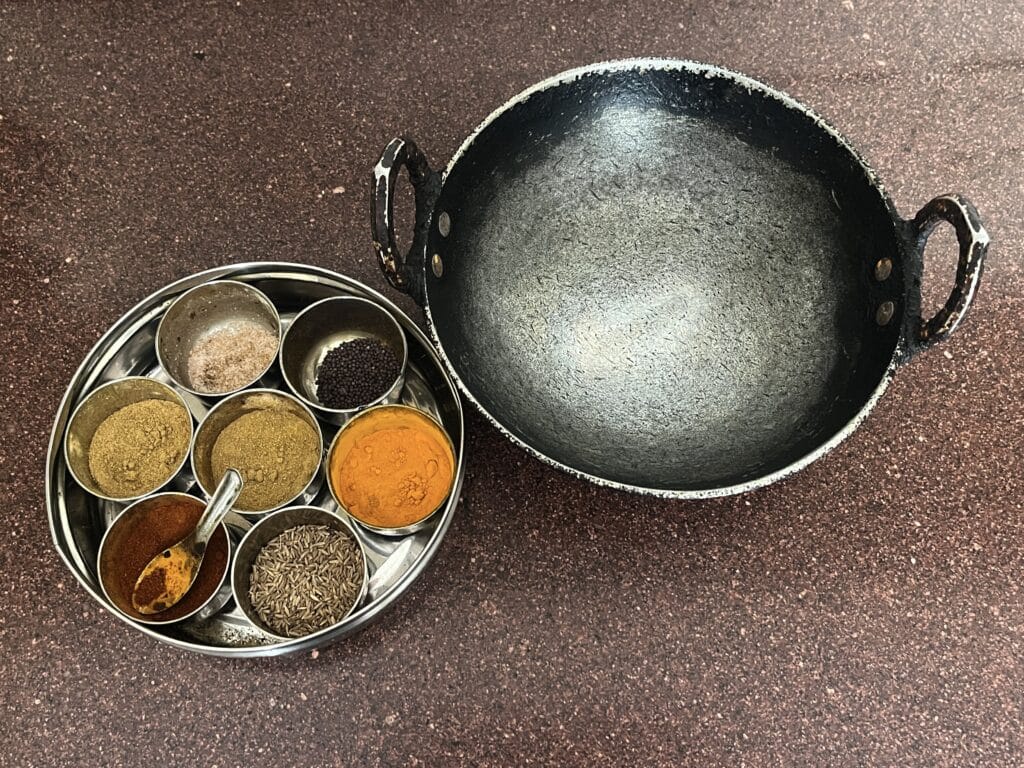
It is a small kadhai – a little more than a foot in diameter – which could be tasked to rustle up just enough sabzi to feed a young family of four, which was just the kind my grandparents intended to raise. In a time when it was common – almost expected – to have many children to support the family with multiple incomes (and then a couple more for good measure) they heeded the government exhortation of “Hum do, Hamaare do”. Their little family was complete nine years after their wedding, with a pensive little girl and a strapping young boy – my aunt and father – coming along and helping themselves to copious amounts of bhindi and parval from the little kadhai.
In those early years, the kadhai saw much travel as the young couple – and then young family – were bundled up and moved around according to the pressing demands of my grandfather’s bank. Lucknow, Agra, Banares and Calcutta have all had their ingredients and recipes pass through the little steel crucible, and it became all the richer for it. Over the years, the stainless steel has lost much of its shine, but continues to take pride in being a dignified dull grey, unlike its aluminium cousins that would have lost all their lustre a few years into their lives. As is with most utensils subjected to the torturous temperatures of Indian cooking, it is crusted black around the rim, reminiscent of the gnarled barks around great trees. And perhaps there is much more to that analogy, as the kadhai remained rooted in the family for decades, and like vines and moss and creepers, the family found nourishment in the meals it served.
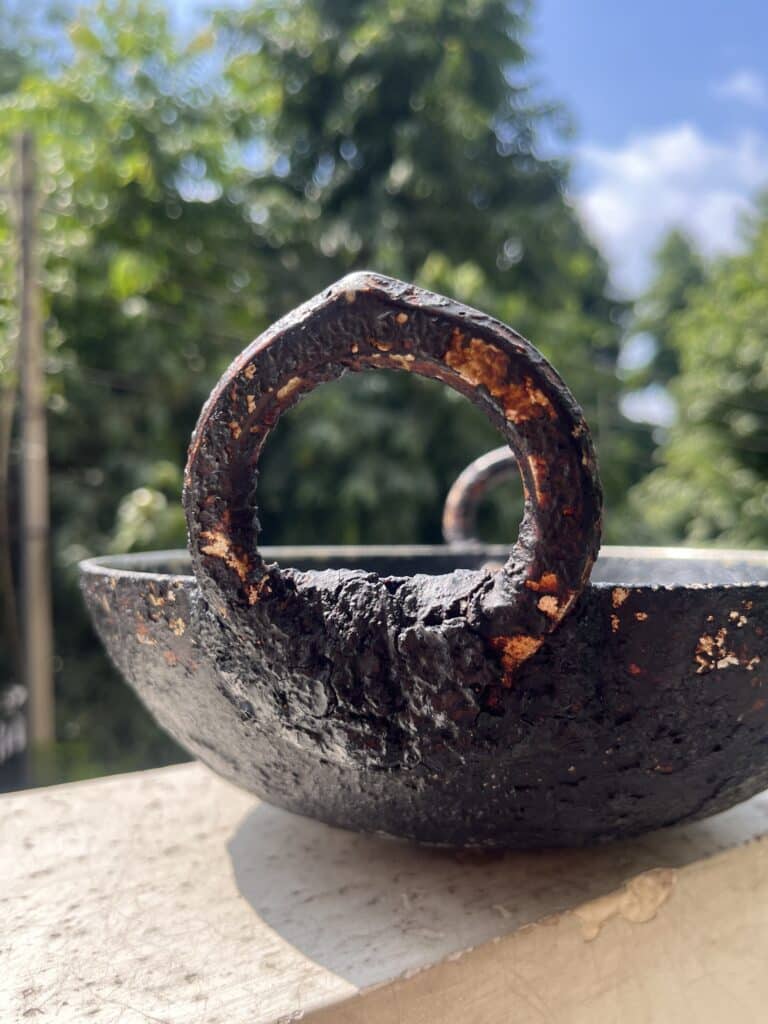

Its handles aren’t the standard circular rings that one finds on most kadhais, but onion shaped. Almost as if they were inspired by a cross-section of the dome of the Taj. I can’t be certain whether there was any material logic to this, but the women in my family who used it the most – their hands hardened by the metal and fire of their kitchens – claimed the handles remained considerably cooler no matter how much the kadhai was heated. They were able to hold its handles and move it around without having to use a saansi – a pair of tongs in my family’s half-Hindi-half-Marathi lexicon.
My father learnt to cook in this kadhai. Perpetually dissatisfied with the cold, dry lunch my grandmother left for him before she went to work – she was an instructor of stitching, needlework and embroidery in Lucknow – he would come home from school, throw all caution and prudence out the window, and prepare a fresh portion of daal and rice for himself that was literally awash in desi ghee. My grandmother lamented for decades how there was always too much food to finish at the end of the day, and how the household was always short on ghee and grain. My father inherited the kadhai when he got married to my mother. The eldest daughter of a Kayasth family in the employ of British infrastructure corporations in India, she came from a far more prosperous home and never had much cause to enter kitchens when she was growing up. Now confronted with the expectation to cook for two young children and a husband already well-versed in culinary techniques, she did perhaps the best she could.
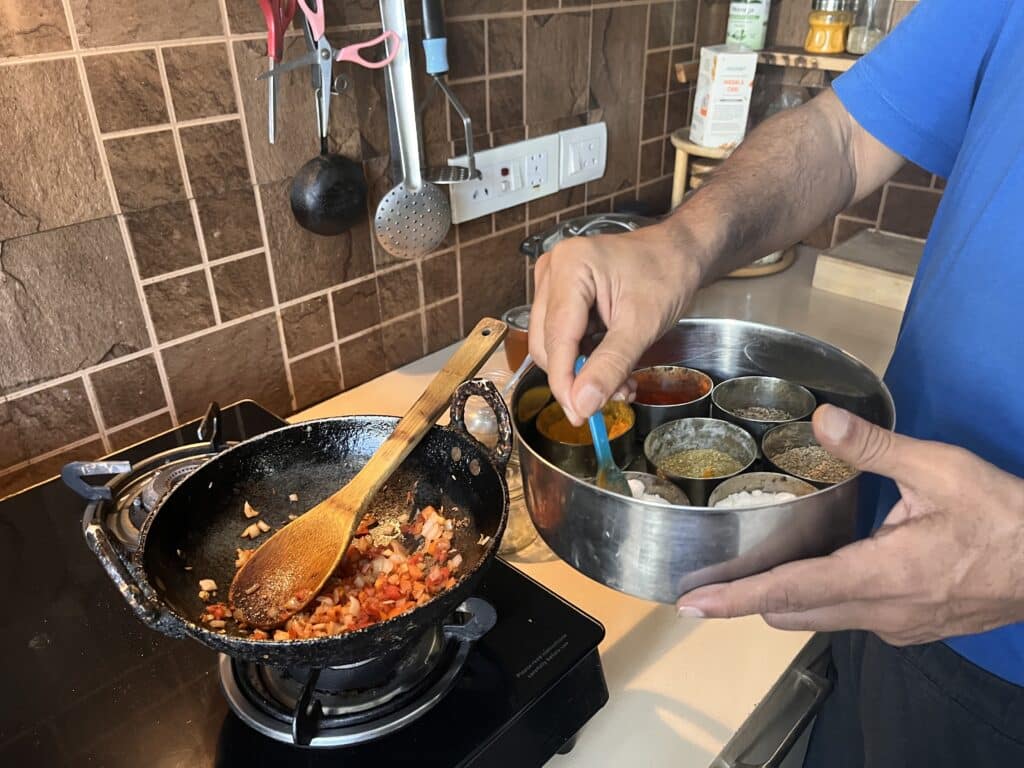
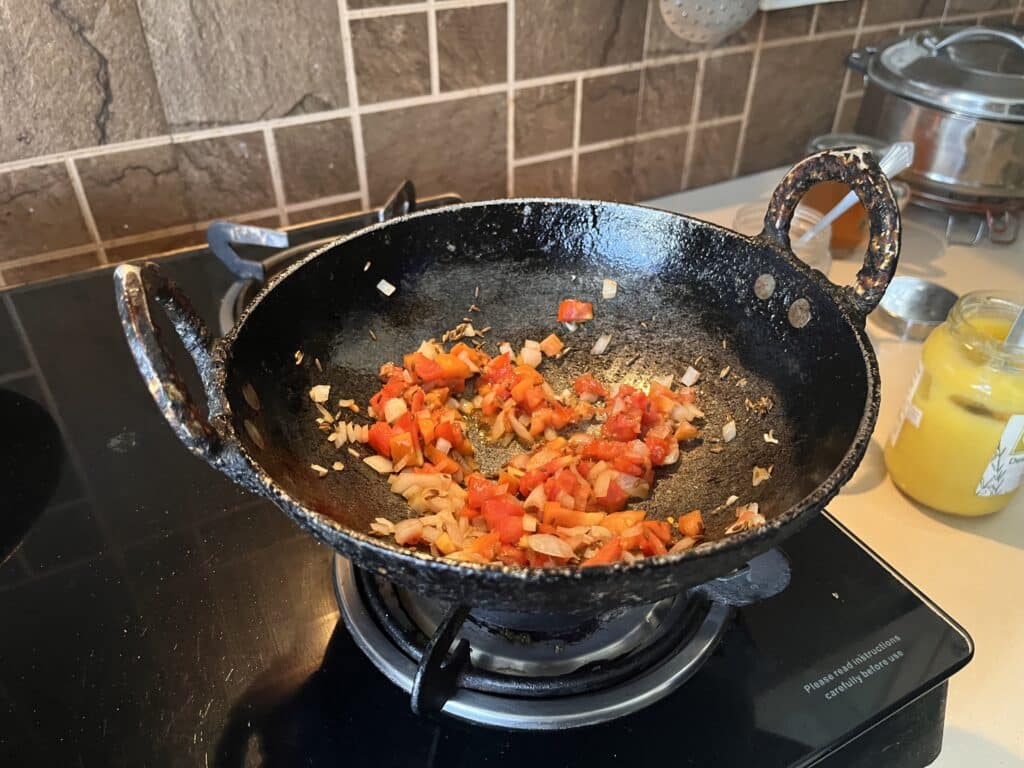
There was much experimentation-gone-wrong, frequent inconsistency even in repeated recipes, and little thought given to flavour profiles. My sister and I grew up for the most part never quite understanding the charm of ‘Maa ke haath ka khaana’, forever pining for restaurants or finding excuses to dine with our Malayali friends downstairs. Unlike the typical Indian household, we waited for Sunday lunches when my father would take charge of the kitchen, and rustle up his rich, ghee-laden delicacies, giving mum a well deserved and much appreciated break.
My mother’s skills in the kitchen have improved dramatically over the years – more from repetition and desperate innovation rather than any new found love – as she grew into her own style of five minute cooking. Like the generation before them, my parents also moved around the country, and both cook and Kadhai once again borrowed ingredients and inspiration from Delhi, Madras, Bombay and Pune. I like to believe that somewhere, somehow, that kadhai played a role in helping her experiments-gone-wrong become experiments-gone-right, even if it was just one of silence, patience and endurance.

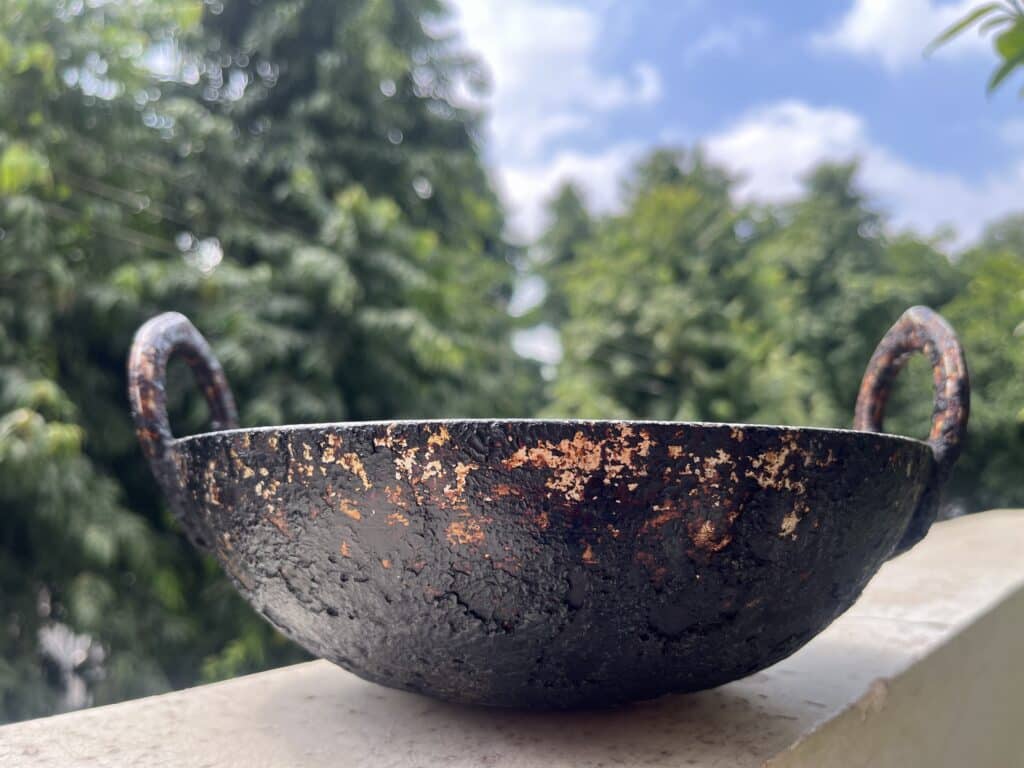
I was bequeathed the kadhai when I left home to join my first job in Delhi. I was expected – and prepared – to build my own household with my earnings but at the last minute this kadhai was shipped over along with a few other essential articles from home. Perhaps my parents saw it as some sort of material seed capital as I bootstrapped my way into adulthood, perhaps it was an act of unspooling and extended the culinary thread that had held the family together.
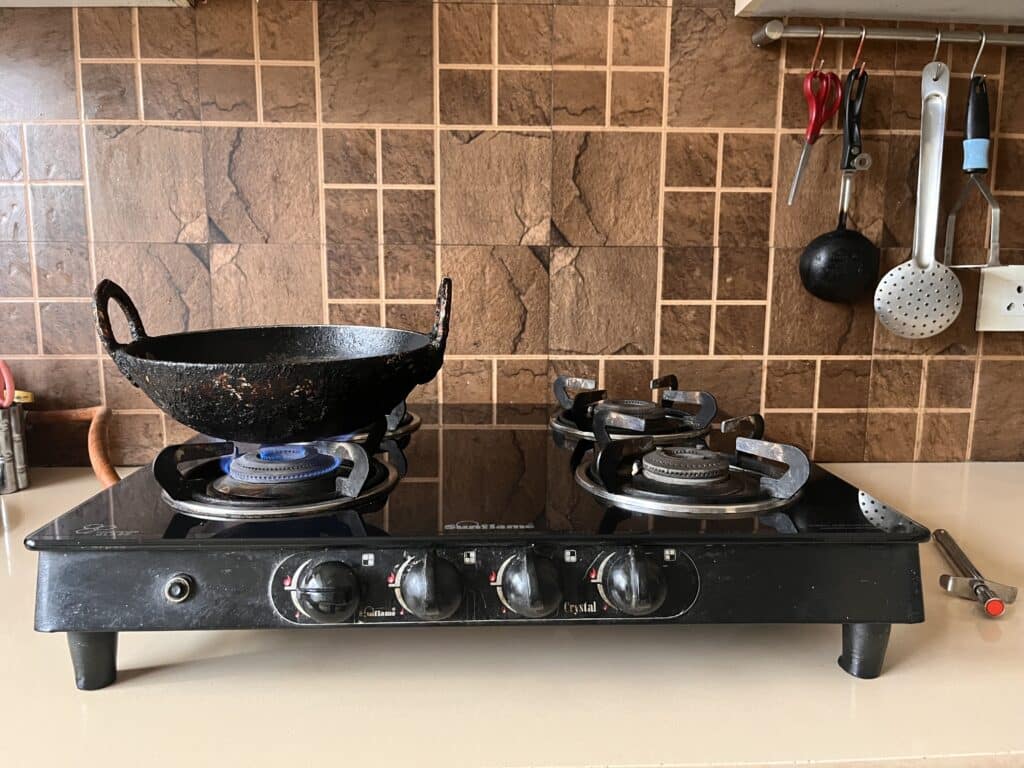
In the decade or so that it has remained with me, I doubt I have used it to even a fraction of its true potential. I suppose the most monumental departure the kadhai has seen in my fledgling household has been the introduction of meat as an ingredient in the curries I made. For over half a century, the kadhai remained the pride of a rigidly Brahmin kitchen and never even saw the likes of onion and garlic, let alone chicken. For cuisine – like opinions and ideas – also changes with the times. It must. And as I came to understand just how central food was to identity, privilege and hierarchy in India, I was compelled to depart from the traditions of my family and embrace the realities of my times. While I can’t speak for how the kadhai feels about this, I hope it is able to move past any Brahmin pride it may have inherited from its time in my grandmother’s and mother’s kitchens, and recognise that the deviations of my household still align with a larger idea of family.
Sometimes, it is amusing to imagine that a humble cooking pot should play such a central role in the lives and times of people who’ve done arguably greater things than it has. But then again, perhaps it is only a humble cooking pot that can stake that claim. Because from the ephemeral nature of its own yield – aromas that are cavernously inhaled, delicacies that are ravenously devoured – emerge the timeless, enduring bonds of love, family, and memory. A nourisher of souls, just as much as a nurturer of bodies. As I write this, I stand in contemplation of my own past and future. The next link of the chain that is my family is still a question mark. And as I wonder whether I want someone of my own to nourish, the kadhai – stoic, dignified and patient as ever – wonders with me.
